Industrial Crops and Products ( IF 5.9 ) Pub Date : 2021-05-05 , DOI: 10.1016/j.indcrop.2021.113604 Wenshi Hu , Zhifeng Lu , Fanjin Meng , Xiaokun Li , Rihuan Cong , Tao Ren , Jianwei Lu

|
The seed yield of oilseed rape (Brassica napus), an important edible and industrial oil source, is derived mainly from the photosynthetic products of siliques. High temperatures in the pod-development stage threaten the oilseed rape production. Fertilization promotes the growth and yield of oilseed rape. However, it is unclear whether fertilization can alleviate the effect of the temperature on the yield. During 2017–2019 oilseed rape growing season, two oilseed rape cultivars with different K utilization efficiencies (KUtEs) were grown with four K fertilizer rates (0, 60, 120, and 180 kg ha−1) to study the association between the application of the stress-resistance-related element K and silique canopy temperature of oilseed rape. Infrared imaging was used to determine the canopy temperature of the two cultivars at the silique development stage at different K application rates. Partial least squares path modeling (PLS-PM) was used to analyze the potential physiological mechanism of the increase in crop yield with K fertilization. The K fertilization reduced the canopy temperature, specifically, the canopy temperature variation (CTV), at the silique development stage (reduction of 1.3–3.0°C by 1 % increase in K amount). A reduction of 1°C in CTV increased the seed yield by approximately 417.6 kg ha−1. Nevertheless, the cultivar with a low KUtE required almost twice the K amount, compared with the cultivar with a high KUtE, to achieve the same consequent CTV reduction, and produced a lower seed yield at the same K application rate. The reduction in CTV was induced by an increased stomatal function (transpiration rate), which was accelerated by the K application. PLS-PM showed that the K application promoted seed yield by reducing the CTV and increasing the photosynthetic rate and biomass. The photosynthetic rate and biomass were directly affected by the CTV. Overall, the K fertilization combined with the high KUtE cultivars could efficiently maintain a stable canopy temperature microenvironment to promote oil production.
中文翻译:

施钾减少甘蓝型油菜的角冠层温度变化,提高种子产量
油菜(甘蓝型油菜)(一种重要的食用和工业油源)的种子产量主要来自长角果的光合产物。豆荚发育阶段的高温威胁着油菜的生产。施肥促进油菜的生长和产量。但是,尚不清楚施肥是否可以减轻温度对产量的影响。在2017-2019年油菜油菜生长季节,两个钾肥利用率(KUtEs)不同的油菜油菜品种以4种钾肥速率(0、60、120和180 kg ha -1种植))研究抗应力相关元素K的施用与油菜油菜角冠层温度之间的关系。在不同的钾肥施用量下,在果树发育阶段使用红外成像确定了两个品种的冠层温度。偏最小二乘路径模型(PLS-PM)被用来分析钾肥增加作物产量的潜在生理机制。在长角果生长阶段,钾肥降低了冠层温度,特别是冠层温度变化(CTV)(降低1.3-3.0°C,钾含量增加1%)。CTV降低1°C可使种子产量增加约417.6 kg ha -1。然而,与具有高KUtE的品种相比,具有低KUtE的品种需要几乎两倍的K量,以实现相同的结果CTV降低,并且在相同的K施用量下产生较低的种子产量。气孔功能(蒸腾速率)的增加导致了CTV的降低,而钾肥的施用加速了气孔功能(蒸腾速率)。PLS-PM表明,钾肥的施用通过降低CTV和增加光合速率和生物量来提高种子产量。CTV直接影响光合速率和生物量。总体而言,钾肥与高KUtE品种的结合可以有效地维持稳定的冠层温度微环境,从而促进石油生产。


























 京公网安备 11010802027423号
京公网安备 11010802027423号